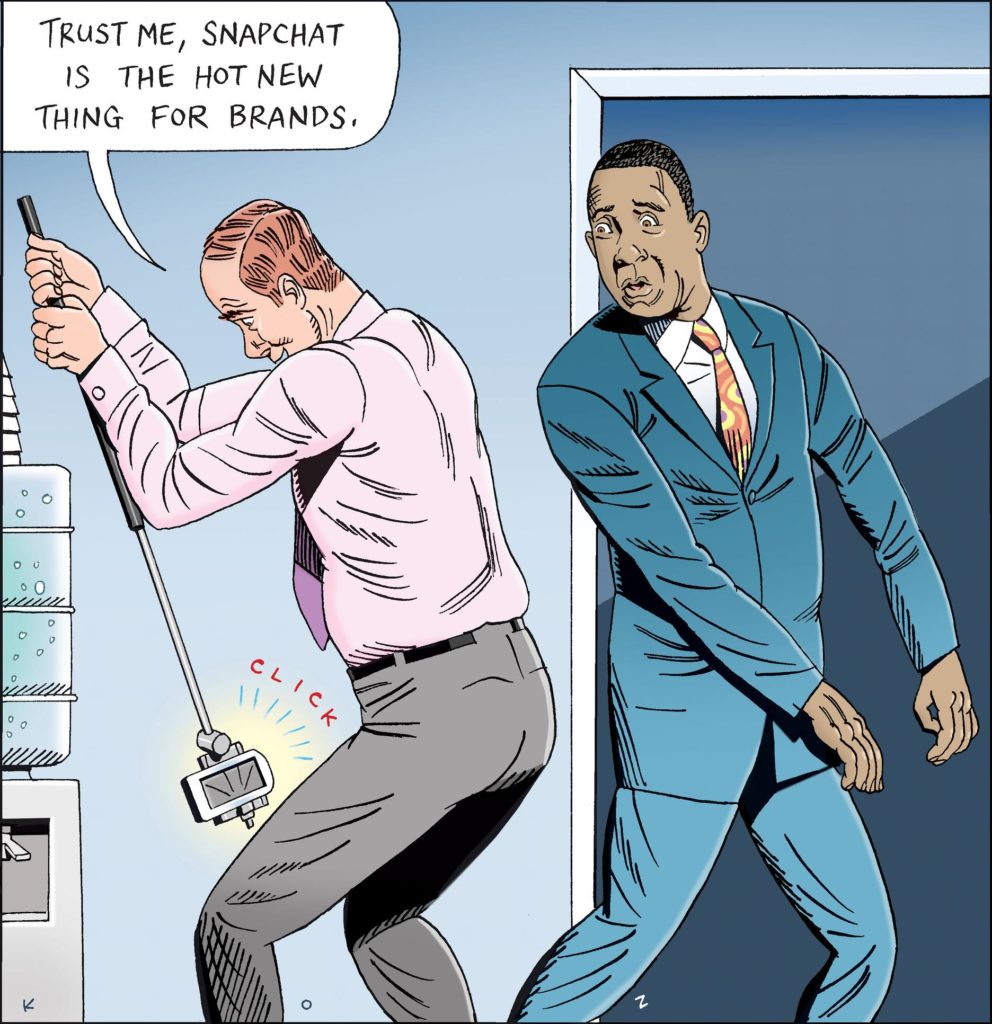Brands
Contently Comic: Snapchat Syndrome
My first real paying editorial job was as the social media editor at a fast-growing parenting site for hip Park Slope moms. It was 2010, a terrible time to get an editorial job, but a great time for bullshitting if you were young and knew how to use Twitter. I had little idea what I was doing as a social media editor, but after years of being raised by a team of women in my mom’s animal hospital, I was adept enough at mimicking the cool mom voice in tweets and Facebook updates to get by.
Like all digital sites back then, we were very reliant on Google. On the day of the Royal Engagement, for instance, we sacrificed 50 bloggers to the Google gods, going as far as to post three separate stories speculating what appetizers would be served at the Royal Wedding. Social, on the other hand, drove a small sliver of our traffic, so my job performance was mostly meaningless. Until one day, our Google rankings plummeted, and all hell broke loose.
“We need to make this back on social,” my boss decreed.
At the time, the big four social networks were Facebook, Twitter, Foursquare, and Tumblr. We were already on Facebook and Twitter, and no one was going to check into our content on Foursquare. So Tumblr, our editorial director reasoned, would be our salvation in these dark days. It was hot! It was bloggy! There was that one article about how Newsweek used it with moderate success!
The only problem was our Park Slope mom-style readers weren’t using Tumblr. I found a bunch of pregnant Canadian teenagers posting about Bright Eyes and sharing Mean Girls GIFs, but that was about it. When I tried to explain to my boss that our audience simply wasn’t on the platform and we couldn’t drive any meaningful traffic from it, she didn’t want to hear it. She had read about Tumblr everywhere. I simply wasn’t trying hard enough. So I kept plugging away and failing, only escaping the chopping block when I was able to quit after the editorial startup I was working on by night miraculously got funded.
I think about that job a lot. My boss had shiny-new-object syndrome, and it’s something that constantly infects the media and marketing worlds. Anyone crazy enough to get a soft arts degree and go into the media/marketing world is inherently optimistic, and as such, we’re always hopeful that the next big platform will be our magic carpet shortcut to kickass success.
There’s also sexiness and coolness in the new, and the inescapable desire to be a part of it. That’s why brands agreed to Snapchat’s initial demands to pay $750,000 on the platform, even though no brand (other than lingerie companies) had a very good idea of how to use it. That’s why when Ello came out, everyone clamored to join, and when Meerkat got hot, every marketer in my Twitter feed started livestreaming meetings, seemingly eager to share the boring mundanity of their office lives with the rest of the world, but in an innovative way as an early adopter. Plus, there was potential! The potential that every hot new platform makes to fast-track us up the Content King leaderboard.
I talked about this trap the other day in an interview with LinkedIn’s Jason Miller. Among content marketers, Jason is pretty out-there; he somehow convinced Marketo to release a marketing activities coloring book as a piece of lead gen, and it worked like gangbusters. And he had some advice for marketers in pursuit of their manic pixie dream platform.
“I see a lot of egos hijacking content strategies,” he said. “I see a lot of people doing Meerkat sessions that have no business value. It doesn’t make a lot of sense to me. In order to be a successful content marketer, you have to do a tremendous amount of trial and error, but you have to have a foundation to support your trial and error.”
That’s great advice. Always be on the lookout for the next big thing—I’m sure every retail company that didn’t experiment with Pinterest early is kicking itself—but don’t let looking for the next big thing be your only content strategy.
As Miller added: “You certainly shouldn’t be trying to do anything unless you have some sort of foundation driving the results while you are trying to figure out what to do next.”
Create a foundation that works for you—that drives solid results and delivers value to people—and then experiment with the extra 5-10 percent of your time. Go ahead and make your brand a Snapchat. Just be sure to keep the camera pointed above the waist.
Image by Martin KozlowskyGet better at your job right now.
Read our monthly newsletter to master content marketing. It’s made for marketers, creators, and everyone in between.





